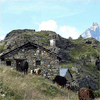|
|
|
Valle d'Aosta Guide Italy
|
|
|
|
 |
|
|
|
|
|
Directories of Web Sites:
Valle d'Aosta Italy
Valle d'Aosta Hotels
Valle d'Aosta Guide
When the glaciers that had nearly completely covered it had melted, the Aosta Valley was inhabited from the Neolithic age onwards. Probably with the Iron Age appeared the fierce and combative Salassi: a Celtic or Celtic-influenced ligurian people (according to some interpretations) that took over the valley until 25 B. C. They were then subdued by the Romans with much effort, a good sixty years after the first attempt at occupation. The foundation of the Augusta Praetoria marked the start of the Roman colonisation of the region. After the fall of the Roman empire and the subsequent domination by various groups (Ostrogoths, Lombards and Franks), the Valley passed into the hands of the Burgundian kings in 888 A. D. who were then succeded in 1032 by Umberto Biancamano, founder of the Savoy family: a reign which was to last until the birth of the Kingdom of Italy. The Savoy family granted the Aosta Valley a large scope of autonomy, realising the difficulty of total domination over such an incaccessible territory, which was diveded into small dominions. In the 16th century the Aosta Valley maintained its own law code nearly up until the French revolution: the "Countumier". Published at Chambéry in 1588, it was the Book of Customs, or rather rules, never yet committed to writing, which governed the way of life of the Valley, presided over by the Three States Assembly and by the Conseil des Commis. From then on, apart from short periods of French occupation in the 17th and 18th centuries and during the Napoleonic wars, the Valley followed the ways of the House of Savoy. In more recent times the gold medals conferred on the "Aosta" and " Cervino" battalions, and the Resistance movement lead by Emile Chanoux were the most glorious moments in the Valley's history, which merged from 1861 onward with that of Italy.
Aosta Valley can be considered the Palace of "Her Majesty the Snow": with the highest, the most famous and the most beautiful mountains in the Alps, winter sports are a natural gifts here. You can do something different every day of your holiday: downhill skiing, cross-country skiing, ski-touring, snowboard, fun carving, heliskiing, ice-climbing...
Monterosa Ski. It is one of the Europe's skiing masterpieces: the skiing area covers over 200 kilometres of snow, with 56 runs served by 42 skilifts. You can reach by skilifts the Ayas Valley, the Gressoney Valley.
Dominated by the pyramid of Monte Zerbion and the imposing castle of Ussel, Saint-Vincent is an elegant tourist and high-level sports centre, with top European-level hotels. It is the fashionable heart of Aosta Valley with famous restaurants and one of the biggest Casinos in Europe: the Casino de la Vallée. A few kilometres from Saint-Vincent, at 1640 metres, there is the Col de Joux which straddles Ayas Valley and the central valley of the Dora. Wide, flat, covered in pine woods, it offers 7 km of intermediate-level downhill pistes.
Courmayer offers the best opportunities for shopping, entertainment, bars and cafÎs, restura">taurants, but also the mountain atmosphere of its little streets, or the undisputed charm of its typical villages such as Dolonne and EtrÎves. The skiing area has 100 kilometres of downhill runs, easy and difficult alike. Some pistes are famous for their intoxicating length, others because they host famous competitions, yet others are ideal for snowboard or telemark; at Dolonne you can also sky by night.
Below the Matterhorn's splendid silhoutte, Brueil-Cervinia is a world-famous skiing resort. Its skiing area with over 150 kilometres of pistes is one of the biggest in the Alps and you can ski all day without ever doing one run twice. Snowboard enthusiasts will find their paradise in Breuil-Cervinia's Snow-Park. Valtournenche is located below the picturesque chain of the Grandes Muralles and it has a vast skiing area between Monte Roisetta and Grand Sometta, with magnificient views of the Matternhorn. Visiting this area you cannot miss Chamois that is the only village in Aosta Valley inaccessible by car. You can reach it by cable car in a spectacular leap of 800m from the fraction of Buisson.
From the 530 metres of Nus you can reach Lignan (1633m) a small village at the foot of Mont Faroma and the Becca del Luseney. Its wide natural spaces are ideal for peaceful-holiday lovers and there are easy downhill runs, perfect for children and beginners. Other sking-resorts in the area are Saint-BarthÎlemy, Saint-Denis, Verrayes. Valpelline, near to the Great St. Bernard, has four small ski resorts: their easy pistes make them ideal for those who want to learn how to ski. The Great St. Bernard valley has a history as old as its forests. What has always been the essential crossing-point in the Alps, is now a meeting-point for sports, folklore traditions and gastronomy...
La Thuile is part of an international skiing area, linked to the runs of La Rosiére in Savoy by the same ski-lifts and skipass. There are over 150 km of runs, some intermediate level, others idea for the more expert skiers: one of the Alps' biggest and highest skiing areas. In winter the Little St. Bernard road is transformed into a spectacular downhill run, with numerous refreshment points which can even be reached in the evenings by motor sled. Valgrisenche, Rhemes Valley, Valsavarenche, Cogne Valley, Pila and the Central Valley are other famous skiing areas in this unique region...
(Part of the contects and the photos are gently given by the Autonomous Region of Aosta Valley)
|
|
|
|
Acquista la tua visibilità su Travel Plan
|
|
|
|